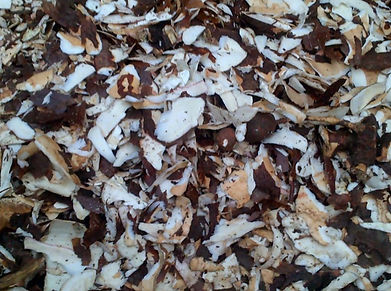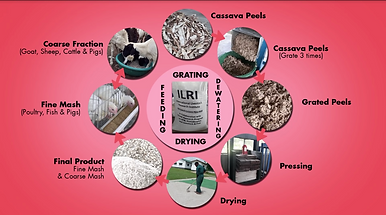


Dried High Quality Cassava Peel (DHQCP)
An innovative process turns cassava waste into valuable livestock feed and is ripe for scaling out.
Nigeria is the largest producer of cassava in the world, growing about a fifth of the global harvest, some 57 million tonnes in 2016. While this rise has undoubtedly helped to alleviate hunger in the country, it creates a mountain of waste – estimated at 15 million tonnes a year – that causes environmental and health problems.
In 2015 the International Livestock Research Institute (ILRI) and the International Institute of Tropical Agriculture (IITA), supported by the CGIAR Research Program on Roots, Tubers and Bananas (RTB), together launched the Cassava Peel Project, which I lead, to address the problem of cassava waste.
The heart of the project was a procedure we developed that converts wet cassava peel into energy-rich, high-quality animal feed. First, the fresh peel is grated three times, to reduce the particle size and make it easier to dry. The grated peel is packed into sacks that are placed in a hydraulic press that removes more than half of the water content. The sacks are left overnight to ferment and the resultant wet cake, which stores for up to a week, can be fed directly to cattle, sheep and goats, and pigs. The wet cake can also be grated again to break it up and the particles sieved into fine and coarse fractions. These fractions are dried in the sun or overheat, and will then store for up to six months. Dried fine cassava mash can be fed to poultry, fish, and pigs, while the coarser mash is suitable for cattle, sheep and goats, and pigs.
Fresh cassava peels have 3 main deficiencies: they spoil very quickly, they contain phytates and large amounts of cyanogenic glycosides.
They should thus be processed in order to reduce cyanogenic potential and phytate content and to preserve their nutritive quality
Different processes are effective in reducing cyanogenic glycoside including sun-drying, ensiling, and soaking + sun-drying. All these methods have yielded satisfactory results.
Good quality silage can be obtained after chopping the peels to equal lengths of about 2 cm for easy compaction, and wilting for 2 days to reduce moisture content from 70-75% to about 40%. Under these conditions, cassava peel silage after 21 days was light brown in colour, firm in texture and had a pleasant odor. The pH was 4.4, and no fungal growth was observed.
In Nigeria, drying cassava peels on black plastic sheets has been drawing the attention of smallholders and was the winning project of the 2008 Global Development Marketplace (a grant program held by the World Bank): "Using cassava waste to raise goats".
Solid fermentation of a mixture of cassava peels and waste water from fermented cassava pulp with Saccharomyces cerevisiae and Lactobacillus spp. resulted in a product with a higher protein content, lower cyanogenic glycosides and lower phytate content.



